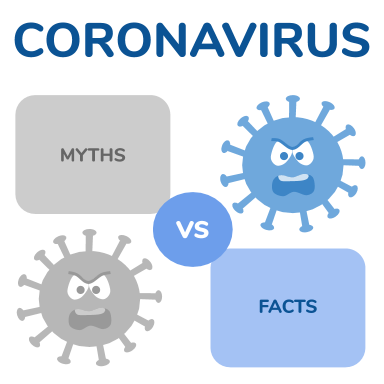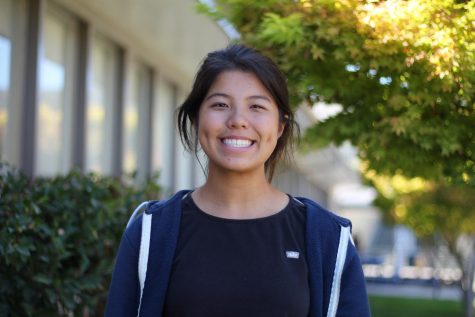Debunking COVID-19 myths
Accompanying the rise of COVID-19 is a flood of misinformation regarding the disease. To help separate the fact from fiction, The Talon has debunked five of the most prevalent COVID-19 myths.
April 18, 2020
Myth #1: Masks don’t help prevent the coronavirus
Fact: Masks are an effective preventative measure against coronavirus.
The World Health Organization (W.H.O.) and Center for Disease Control and Prevention (C.D.C.) falsely stated that regular surgical masks did not help prevent a healthy person from catching COVID-19, but rather only helped sick people prevent spreading the disease to others. This information was parroted to the American public by several politicians and health experts, including Surgeon General Jerome Adams.
However, this information was spread in an effort to prevent overzealous, concerned citizens from hoarding masks and creating a shortage for healthcare workers.
On Friday, April 3, the C.D.C. retracted its previous claims by declaring that cloth masks should be worn “in public settings where other social distancing measures are difficult to maintain.” Experts have shown that the virus can spread through talking and breathing, not just coughing, so covering your mouth will hinder the spread of the virus. And while masks aren’t 100 percent effective, they result in a lower viral load upon infection, which means your immune system has to fight off less of the virus in its initial stages. For example, places like Hong Kong and Taiwan have much lower infection and death rates despite significant travel from China because they required all citizens to wear masks early on. There has also been an increasing trend of asymptomatic people who are unaware that they are sick, but are still transmitting the virus to others. Thus, everyone should wear masks to mitigate the chances of asymptomatic people unknowingly infecting others.
So if you do go to a public place, please wear a mask. Even if you don’t have any masks available, a homemade mask is better than nothing, so we’ve linked a few resources below to help you make a mask at home:
Myth #2: The coronavirus will subside by summer
Fact: The coronavirus may follow typical annual flu patterns, but it’s possible that it will continue into the summer like the 2009 swine flu pandemic. More laboratory experiments on the survival of SARS-CoV-2 are needed to predict the next few months, but don’t count on any summer plans quite yet.
This myth arose because people believed that the coronavirus would follow the annual pattern of the common cold and flu, which spread more easily in colder months but ease up when the weather warms. Many studies by researchers have found that, so far, colder areas have higher rates of SARS-CoV-2; however, there have also been a significant number of cases in tropical areas, such as Guangxi and Singapore.
In an interview with CBS News, director of the Climate and Health Program at Columbia University Jeffrey Shaman says that while the common flu peaks in the winter and goes away in the spring, a pandemic influenza outbreak may extend into the summer, like the 2009 swine flu.
“There is heightened susceptibility in the human population that allows for transmission even as humidity conditions rise,” Shaman explained.
The 2009 swine flu went away in June, but resurged in late August and September as humidity dropped.
“If this novel emergent coronavirus were to follow this pattern, then it would probably continue circulating until May or June, then we’d get a break, and then we might get a second wave of it in September,” Shaman said.
Myth #3: The coronavirus is just as deadly as the flu
Fact: While both COVID-19 and the seasonal flu share symptoms such as fever, cough and aches, COVID-19 is much more serious for a number of reasons.
While estimates vary widely, COVID-19’s mortality rate is predicted to be between 1 percent to 4 percent overall. The flu’s mortality rate varies from year to year with different strains, but is significantly lower at around 0.1 percent.
Not only is the novel coronavirus’s mortality rate at least ten times greater, but people are also much more likely to get COVID-19 than the flu. The C.D.C. estimates that about 8 percent of the U.S. population gets sick with the flu every year. According to predictions from the C.D.C., between 160 million and 214 million people in the United States could be infected with COVID-19—that’s 48 to 65 percent of the population.
Perhaps most importantly, we are not prepared for COVID-19. We know a lot about the flu and have a vaccine for it, but it will take at least a year—if not longer—to develop a treatment for the coronavirus.
Myth #4: The coronavirus was engineered in a lab in China.
Fact: The coronavirus originated from natural causes.
Kristian Andersen, Ph.D., an associate professor of immunology and microbiology at Scripps Research, analyzed the public genome sequence of the novel coronavirus and found that there was no evidence that it was engineered by humans. The most likely scenario is that the virus evolved into its current pathogenic state in a non-human host and then jumped to humans. Andersen, along with several other scientists, thinks that this non-human host species is a bat since SARS-CoV-2 is very similar to a bat coronavirus.
Myth #5: The coronavirus came from a woman who ate bat soup.
Fact: While the coronavirus may have spread to humans from a bat, it did not come from a person eating bat soup.
While scientists believe that the novel coronavirus originated in bats, the myth that the coronavirus came from bat soup was propagated by a widely-circulated video of an Asian woman eating bat soup. However, the woman in the video, Wang Mengyun, is the host of a travel show. In the video, she was not in China, but Palau, an island in the western Pacific Ocean, and the video was filmed in 2016.
So, where did the novel coronavirus originate from? Most likely the wet markets in Wuhan, China, where wild animals are packed closely together and sold as food or pets. In an investigation of the first cases of COVID-19, researchers found over half of the first 41 cases of pneumonia had “contact or exposure to the market.”
The mixing of different species in cramped conditions such as the Wuhan market allows for viruses to transfer much more easily. Scientists believe that bats were the first carriers of the coronavirus, but there are no documented cases of transmissions from bats to humans, so there might have been an intermediate host, such as a snake or a pangolin.
However, some of the earliest cases in China had no link to the Wuhan web market, causing rise to the theory that researchers at the Wuhan Institute of Virology (WIV) studying a coronavirus may have let it escape from the lab due to human error.
So while we can say that the coronavirus did not start from a person eating bat soup, the origins of the virus are still unclear; scientists will need to perform more research before they can confirm anything.



